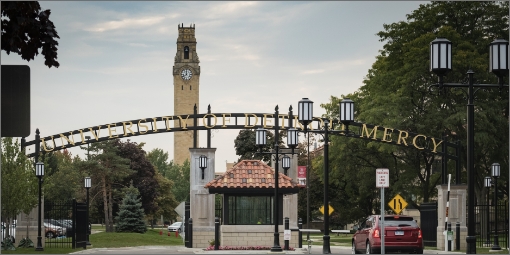 At the University of Detroit Mercy, the one entrance to the campus seems to always be backed up. Such a decision often overlooked is the use of other school building entrances. While it may seem trivial, the choice of which entrance to prioritize can significantly impact safety, traffic flow and overall accessibility. In Detroit Mercy’s case, the prospect of opening the other entrance merits thoughtful consideration.
At the University of Detroit Mercy, the one entrance to the campus seems to always be backed up. Such a decision often overlooked is the use of other school building entrances. While it may seem trivial, the choice of which entrance to prioritize can significantly impact safety, traffic flow and overall accessibility. In Detroit Mercy’s case, the prospect of opening the other entrance merits thoughtful consideration.
The idea of opening the other entrance may not appear as a major problem, but a closer examination reveals many potential benefits. Firstly, by distributing the flow of traffic across multiple entry points, we can alleviate congestion during peak times. Anyone who has experienced the only entrance being backed up can know how stressful it can be when you are running late for class. Opening the other entrance provides an opportunity to mitigate these issues, creating a smoother and safer experience for students and staff.
Also, accessibility is a crucial factor to consider. By offering an additional entrance, we enhance the school’s inclusivity and accommodate individuals with diverse needs. For students with disabilities or mobility challenges, having closer access to certain areas of the campus can make a world of difference. It sends a powerful message of inclusivity and ensures that all members of our school community can navigate the campus with ease and dignity.
Beyond practical considerations, the decision to open the other entrance carries symbolic significance. It demonstrates a commitment to adaptability and progress, reflecting on innovation and responsiveness to the evolving needs of our community. By embracing change and embracing innovative solutions, we set a precedent for proactive problem-solving and continuous improvement—a lesson that extends far beyond the confines of the Detroit Mercy walls.
Of course, any decision of this nature must be made with careful deliberation and consideration of potential challenges. Concerns about security and supervision may arise, but these can be addressed through strategic planning and implementation of appropriate measures. With proper protocols in place, we can ensure that opening the other entrance enhances safety rather than compromising it.
Additionally, logistical considerations such as traffic patterns and infrastructure must be thoroughly evaluated. While the benefits of opening the other entrance are clear, we must also assess the practical feasibility of implementing such a change. Collaborating with traffic experts, community stakeholders and relevant authorities will be essential in navigating these complexities and ensuring a seamless transition.
In conclusion, the decision to open the other entrance at Detroit Mercy is not merely a matter of convenience—it is an opportunity to enhance safety, accessibility and inclusivity for all members of our community. By embracing this change, we affirm our commitment to progress and demonstrate our willingness to adapt to the evolving needs of our students and families. Let us unlock the potential of Detroit Mercy by opening the door to new possibilities.




